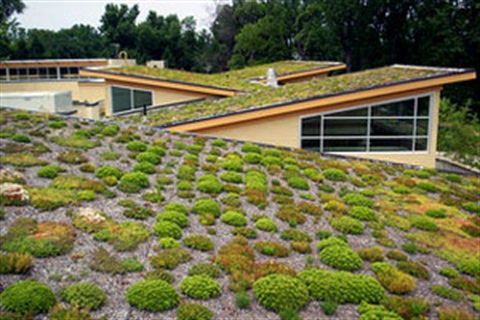Green Roofs

A green roof is a roof made up of layers of soil and plants on its surface; like a traditional roof, there’s a waterproofing layer under the dirt and plants. Rainwater that falls on the roof is absorbed by the soil and taken up by the plants. As a result, less rainwater — and accompanying pollutants — run off the roof and into nearby storm drains and streams.
Benefits of a Green Roof
- Extends the life of your roof by reducing temperature fluctuations that can damage roofing materials.
- Provides additional insulation for your home, which conserves energy and saves you money.
- Reduces runoff from your home, which can help alleviate any drainage or runoff problems that occur in your yard.
- Improves air quality. Plants take up carbon dioxide and release oxygen.
Maintenance
Green roof plants are low-growing and don’t need mowing or trimming. The company that installs your green roof will have recommendations for maintaining it.
Following construction, perform the following as needed:
- Water your roof to promote plant growth and survival.
- Inspect the vegetated roof and replace any dead or dying vegetation.
Conduct the following on a semiannual basis:
- Inspect the waterproof membrane for leaking or cracks.
- Many practitioners recommend an annual application of slow-release fertilization during the first five years of your roof garden.
- Weed the green roof to remove invasive plants.
- Inspect roof drains, scuppers and gutters to make sure they’re not overgrown or that they don’t have organic matter deposits. Remove any accumulated organic matter or debris.
- Inspect the green roof for dead, dying or invasive vegetation. Plant replacement vegetation as needed.
- Plants should be added to bare areas.
If a Roof Leak Is Suspected
We advise you perform an electric leak survey (e.g., Electrical Field Vector Mapping) to pinpoint the exact location, make localized repairs and then re-establish system components and ground cover.
Practices to Avoid
The use of herbicides, insecticides and fungicides should be avoided since their presence could hasten degradation of the waterproof membrane. Also, power-washing and other exterior maintenance operations should be avoided so that cleaning agents and other chemicals don’t harm the vegetated roof plant communities.